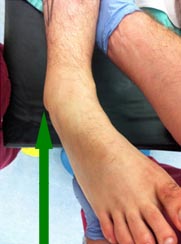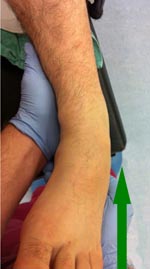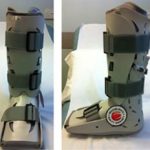
Ankle tilting in excessively under stress due to rupture of the calcaneofibular ligament
What will the surgery involve?
i. Anaesthetic – Usually a general anaesthetic together with a local anaesthetic around the scar (or around the nerves behind the knee- popliteal nerve block). You will have to chance to discuss this with the anaesthetist prior to surgery.
ii. Scar – This will be longitudinal slightly curving forwards on the outside of the ankle.
iii. The surgery – The two main ligaments on the outside of the ankle are shortened and reinforced using a special technique (The Gould modification) .
iv. Stitches – Removable sutures are required which will be removed at your appointment about two weeks after surgery.
v. Dressings – Special dressings will be applied at the end of the operation and a plaster (of paris) will be used to immobilise the ankle and foot. The plaster will only cover the back and the sides of the foot and ankle, to allow for swelling.
The plaster should be kept dry, applying a waterproof cover when showering is useful, the most commonly used can be found at www.limboproducts.co.uk
What happens after the surgery?
i. Return home – Either the same day or the following morning.

The opposite ankle – note the ankle does not tilt inwards to the same degree despite the same stress being applied.
ii. Pain relief – The local anaesthetic placed around the ankle (or possibly around the nerves behind the knee-popliteal nerve block) at the time of surgery will ease the discomfort after surgery, the foot and ankle may feel numb, this usually the case after a popliteal nerve block and can last about 24 hours. It is important to take the pain relieving tablets regularly before the local anaesthetic wears off. You can gradually reduce the frequency with which you take these after twenty four hours.
iii. Walking – You will be need to keep your weight off the operated foot until you are seen in the outpatient clinic approximately two weeks after surgery. At this point the plaster will be removed and replaced by a walking boot; you will be able to walk in this boot placing all of your weight on the foot. The boot must be worn at all times day and night, except when washing when it can be removed with care.
Six weeks after surgery physiotherapy is commenced and the boot exchanged for an ankle brace which should be worn for the next six weeks. You may find the brace reassuring for the following few months when you are undertaking sporting activities.
It is important to keep your foot elevated when you are resting, as much as you can for the first two weeks after surgery (if possible above the level of your heart). If you do not keep it elevated then the foot will swell, throb and be uncomfortable.
iv. Driving – This is not permitted until you can walk confidently in normal shoes, however if the surgery is on your left foot and you have an automatic car you may be able to drive after you are seen in the clinic two weeks after surgery.
In all cases you should check with your insurance company first.
v. Return to work
Office job – 2 weeks
Mobile job requiring driving – 6-7 weeks
Manual labour – 8-10 weeks
 What are the risks of the operation?
What are the risks of the operation?
There are a small number of risks of surgery including infection, nerve damage, blood clots, ongoing pain and the need for further surgery (please see General Risks of Foot and Ankle Surgery for further information)
